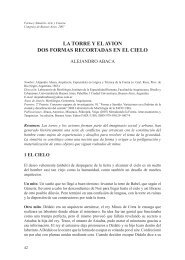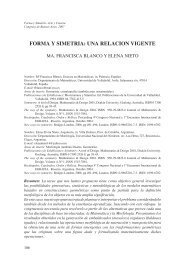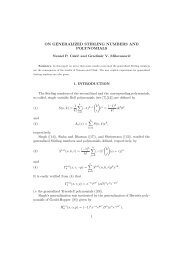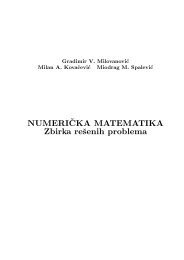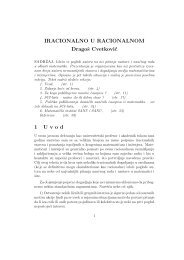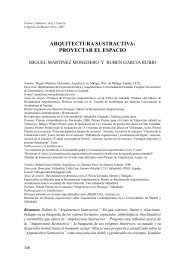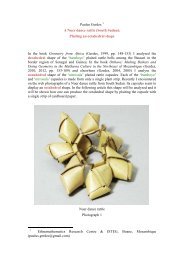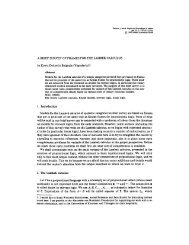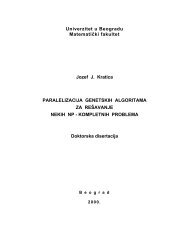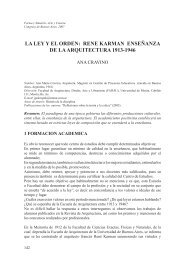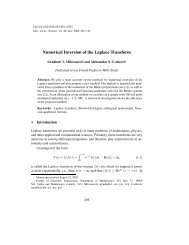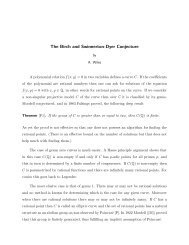Knjiga apstrakata - Mathematical Institute of the Serbian Academy of ...
Knjiga apstrakata - Mathematical Institute of the Serbian Academy of ...
Knjiga apstrakata - Mathematical Institute of the Serbian Academy of ...
Create successful ePaper yourself
Turn your PDF publications into a flip-book with our unique Google optimized e-Paper software.
Functional Decomposition as an Optimization Technique ∗Edin H. MulalićFaculty <strong>of</strong> Electronic EngineeringUniversity <strong>of</strong> Niš, Serbiaedinmulalic@yahoo.comMiomir S. StankovićFaculty <strong>of</strong> Ocupational SafetyUniversity <strong>of</strong> Niš, Serbiamiomir.stankovic@gmail.com1 IntroductionA basic operation such as calculating <strong>the</strong> value <strong>of</strong> a function is in <strong>the</strong> heart <strong>of</strong> any problem solving process. In specializedsystems where <strong>the</strong> speed <strong>of</strong> calculation is <strong>of</strong> great importance, various optimization techniques are applied. There is nogeneral recipe for successful optimization, it usually requires problem dependant heuristic. One can express a functionto be calculated in different ways, use various decomposition techniques, use hardware implementation (or a combination<strong>of</strong> s<strong>of</strong>tware and hardware implementation), improve speed <strong>of</strong> data structures used in <strong>the</strong> algorithm, use precomputedvalues, use approximative solutions etc. In this paper, we will explore <strong>the</strong> possibility <strong>of</strong> taking advantage <strong>of</strong> functionaldecomposition combined with using underlying probability distribution <strong>of</strong> input variables for determining which valuesshould be used for pre computation.2 PreliminariesLet’s suppose that we have given a finite commutative ring (R, +, ∗), where R = {r 1 , r 2 , ..., r K }, K ∈ N. We want toevaluate function f : R N → R, N ∈ N (f(x) = f(x 1 , x 2 , ..., x N ) where x i ∈ R for 1iN.) Computing <strong>the</strong> function valuefor a specific input requires time T c (f). If we have a memory <strong>of</strong> limited size M, we would be able to pre compute andstore function value for up to M values <strong>of</strong> input parameter combinations (input vectors). Assuming that reading a valuefrom <strong>the</strong> memory requires time T M and that T M is significantly less than T c (f), with this approach we can cut down<strong>the</strong> average time <strong>of</strong> evaluating <strong>the</strong> function f. Note that <strong>the</strong> term memory in this context can denote a physical memoryor a convenient data structure. Let’s assume that <strong>the</strong>re is an underlying probability distribution <strong>of</strong> input variables, sothat probability <strong>of</strong> x i = r j is denoted as p ij , where ∑ k=Kk=1 p ik = 1, 1iN. We will also assume that input parameters haveindependent distributions. The information about <strong>the</strong> distribution can be used to find M most probable combinations <strong>of</strong>input parameters and use <strong>the</strong>m for precomputed and stored values. Obviously, that will minimize <strong>the</strong> expected time <strong>of</strong>evaluating <strong>the</strong> function which is given by formula:E f [T ] = T c (f) − P (X M )(T c (f) − T M ) (1)where X M is set <strong>of</strong> all input vectors used for pre computation and P (X M ) is probability that an input vector is used forpre computation.Of course, this is not <strong>the</strong> only way <strong>of</strong> using <strong>the</strong> memory resource. Depending on <strong>the</strong> usage <strong>of</strong> <strong>the</strong> system, this might besatisfying solution. But <strong>the</strong>re are some issues in this approach. First, is it possible to use memory resource in a differentway to reduce average evaluation time even more? And second, how can we affect more than M input vectors? One wayto approach to <strong>the</strong>se two problems is functional decomposition. A decomposition ∆(f) <strong>of</strong> a function f is set <strong>of</strong> functions∆(f) = {F, f 1 , f 2 ..., f D }, such thatf(x) = F (f 1 (x 1 ), f 2 (x 2 ), ..., f D (x D )) (2)where x i (1iD) are vectors formed as sub vectors <strong>of</strong> <strong>the</strong> initial vector x.decompositions <strong>of</strong> formIn this paper, from now on, we are consideringf(x) = f 1 (x 1 ) ⊕ 1 f 2 (x 2 ) ⊕ 2 ... ⊕ D−1 f D (x D ) (3)where ⊕ i ∈ {+, ∗}, 1iD − 1. Basically, that means that we are not examining hierarchical decompositions <strong>of</strong> form g(h(y)).∗ Supported by Ministry <strong>of</strong> Sci. & Techn. Rep. Serbia, <strong>the</strong> project III 04400626



